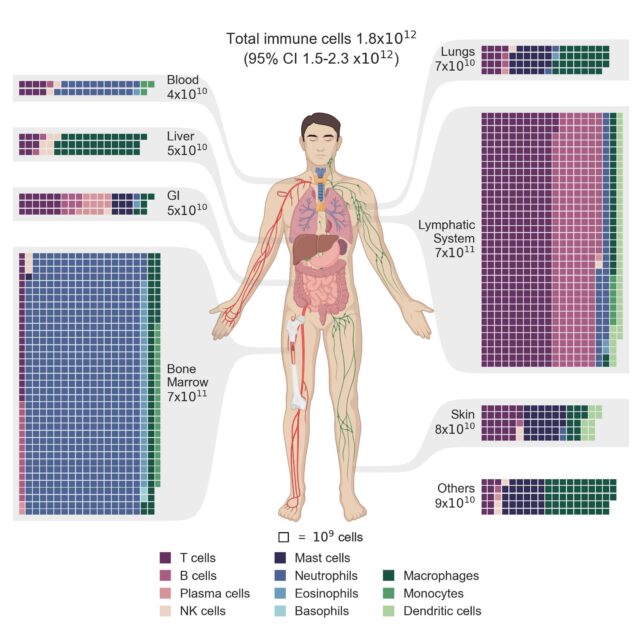Consisting of a variety of tissues primed to protect us against invaders, the body's immune system is a churning mass of around 1.8 trillion cells, new research has found.
If that mind-boggling figure is hard to wrap your head around, put it this way: In an average-sized adult man, those immune cells collectively weigh about 1.2 kilograms or 2.6 pounds – which is about the same as one pineapple, or six hamsters. Though it depends on the size of the person (and the hamsters too).
Unsatisfied with past estimates, Ron Sender, a biologist at the Weizmann Institute of Science in Israel, and colleagues set about calculating how many immune cells there are in the human body, where they reside, and how much they collectively weigh.
Following convention, the authors have relied on the default reference model of the human body – a 70-ish-kilogram adult male between 20 and 30 years of age – which has obvious limitations when extending the results to the other sex, weight, and age groups.
Previous tallies of the immune system have used assorted methods to analyze the male body, which have largely focussed on specific tissues or cell types, or have studied rodents; limiting their generalizability to humans in all shapes and forms in either case.
"Despite the wealth of studies investigating the human immune system from different angles, there is a need for a comprehensive census of the distribution and mass of the various immune cell types," the researchers write in their paper.
One pressing question among immunologists is which organ is the largest reservoir of immune cells in the human body. The gastrointestinal tract is often said to contain the most immune cells, though some studies have pointed to the lymph nodes, not the gut, being the most immunogenic.
Lymph nodes are small bean-shaped tissues along lymphatic vessels where immune cells dwell before rushing into the bloodstream. Yet there is clearly a strong connection between immune cells in the gut, health, and disease.
Sender and his colleague Ron Milo, who is also from the Weizmann Institute of Science, have made somewhat of a name for themselves as cell-counting, number-crunching, myth-busting biologists.
Recently, they have revised estimates for how many bacterial cells reside inside the human body, finding we're not outnumbered 10:1 as was previously thought. They've also calculated how often our body cells replenish themselves: Cells lining the gut are replaced every few days, blood cells turnover every few months, while other cells, like neurons, can last a lifetime.
In their latest study, Sender and colleagues compiled measurements from past research and analyses of tissue samples to estimate the abundance of immune cells throughout the body, noting how immune cell counts can vary with infections, sex, weight, and age.

Researchers extrapolated their results among adult males to estimate the number of immune cells in adult females and children, basing their results mainly on body proportions.
Compared to a 73-kilogram man in his 20s, a female adult of the same age weighing 60 kilogram would probably have around 1.5 trillion immune cells, adding to a total of 1 kilogram. A child aged 10 years would have slightly fewer again: 1 trillion immune cells, weighing 600 grams.
These results, however, need to be interpreted with caution, as women are more likely to experience autoimmune diseases, such as rheumatoid arthritis and lupus, and children's immune systems are still maturing.
Lymphocytes, which raise antibodies to neutralize invaders and mount cellular attacks, make up about 40 percent of immune cells, the study found. But because they are among the smallest cells in the body, lymphocytes represent just 15 percent of the immune system's entire mass.
Neutrophils, which are produced in the bone marrow and gobble up bacterial intruders, account for another 40 percent of immune cells and 15 percent of the system's total mass.
"On the other hand, macrophages, dendritic cells, and mast cells, which are 3 to 10 times larger, make up less than 20 percent of immune cells but contribute to over 60 percent of the immune cell mass," Sender and colleagues write.
What's more, the gut comprises only 3 percent of all immune cells in the human body, while only 2 percent are found in the blood.
That means the most significant immunological organs are actually the lymph nodes, bone marrow, and spleen, where most lymphocytes and neutrophils reside. However, the gut is home to the bulk of plasma cells, and therefore represents the largest contributor to the body's antibody-mediated immunity.
The study has been published in PNAS.
